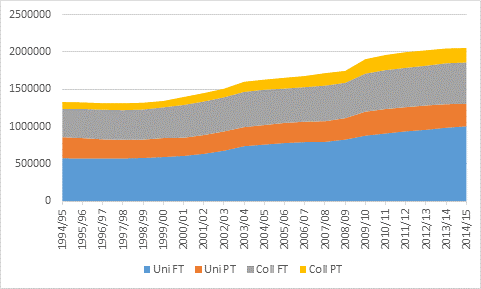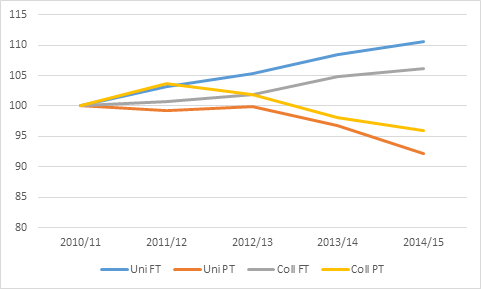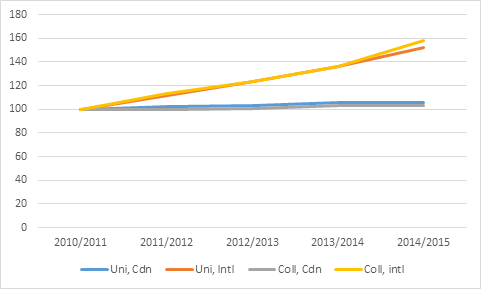Statistics Canada published the 2014-15 enrollment data last week and I thought I would give you a bit of an overview. The data is based on snapshots of enrollment taken in the fall, so we’re talking a 24-month lag here (most other OECD countries can do this in 12-18 months), but this is Statscan so just be glad you’re getting any data at all.
The headline news is that enrollment in 2014-15 was up – barely – from 2.048 million to 2.055 million students (i.e. by 7,000 students), which puts enrollment at an all-time high. As a percentage of the Canadian population, students are thus now 5.8% of the Canadian population. Just to put that into perspective: that’s roughly the population of Saskatchewan and Nova Scotia combined. if students were a province, they would be the country’s fifth-largest. Students make up roughly the same proportion of the population that works in education, law, social services and government services occupations combined, or roughly 5.5 times the number of individuals employed in natural resource occupations.
Figure 1: Enrollment by Level and Intensity, 1994-95 and 2004-05
But while enrollment increased at both universities and colleges, there are some interesting dynamics if you poke around a bit under the hood. The main one is that part-time enrollment fell substantially for the second year in a row at universities and third at colleges. Full-time and part-time enrollments are going in completely different directions at the moment.
Figure 2: Changes in Full- and Part-time student enrollments, 2010-11 to 2014-15 (2010-11 = 100)
The other really interesting trend in enrollments has to do with international students. Over the past five years, total full-time enrollment at colleges and universities has increased by 126,000. 48% of that increase is accounted for by international enrollments. Or, to put that another way: domestic student enrollment has increased by about 5%, but international student enrollment has increased by 56%. These figures are shown below in figure 3. Apologies for lines not being distinct, but that’s a factor of the trends being almost identical in both the college and university sectors.
Figure 3: Changes in Domestic and International Full- time enrollments, 2010-11 to 2014-15 (2010-11 = 100)
That last graph is especially important when you think about institutional finances. Assuming (at a high level of generality) that tuition income from international students is about three times what it is for domestic students, that implies that over 75% of the increase in tuition revenue over the period 2010-11 to 2014-15 comes from international students. I’ll try to get into more detail on this at some point before Christmas, but by my back-of-the-envelope reckoning that makes international student fees responsible for almost exactly 50% of total increase in operating funds over those five years.
Let that sink in for a bit. Fifty percent.
There are a lot of implications to that number.




 Tweet this post
Tweet this post

Love the new look of the email newsletter and the much-needed update to the subject line format!
As Canadians, it makes sense that we could agree to spell ‘enrolment’ the Canadian way, with one ‘l’. Even if you’re labouring under the idea that MicroSoft should teach us all how to spell, American spellings of English words only make sense when the Americans deleted letters in words that seemed excessively long, not added them. In any case, perhaps we could agree to use the Globe & Mail style guide or the Canadian Press style guide.
There’s really no good reason to use the American spelling of ‘enrolment’ in this country.
I’m curious as to whether the definitions of “full-time” and “part-time” are constant and consistent. My impression a few years back was that the University of Victoria, for example, regarded full-time as a full-load: 5 X 3-credit courses per term. Colleges in BC and the new universities, however, characterized 3 X 3-credit courses per term as full-time. Canada Student Loans accepted 3 courses as full-time and that was good enough for many institutions. What’s the skinny now?
– John.